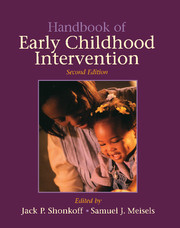Book contents
- Frontmatter
- Contents
- Foreword
- Preface
- Contributors
- PART ONE INTRODUCTION
- PART TWO CONCEPTS OF DEVELOPMENTAL VULNERABILITY AND RESILIENCE
- PART THREE THEORETICAL FRAMEWORKS FOR INTERVENTION
- PART FOUR APPROACHES TO ASSESSMENT
- PART FIVE SERVICE DELIVERY MODELS AND SYSTEMS
- PART SIX MEASURING THE IMPACT OF SERVICE DELIVERY
- PART SEVEN NEW DIRECTIONS FOR THE TWENTY-FIRST CENTURY
- 26 Early Childhood Intervention Policies: An International Perspective
- 27 Evolution of Family–Professional Partnerships: Collective Empowerment as the Model for the Early Twenty-First Century
- 28 Resilience Reconsidered: Conceptual Considerations, Empirical Findings, and Policy Implications
- Name Index
- Subject Index
28 - Resilience Reconsidered: Conceptual Considerations, Empirical Findings, and Policy Implications
Published online by Cambridge University Press: 05 November 2011
- Frontmatter
- Contents
- Foreword
- Preface
- Contributors
- PART ONE INTRODUCTION
- PART TWO CONCEPTS OF DEVELOPMENTAL VULNERABILITY AND RESILIENCE
- PART THREE THEORETICAL FRAMEWORKS FOR INTERVENTION
- PART FOUR APPROACHES TO ASSESSMENT
- PART FIVE SERVICE DELIVERY MODELS AND SYSTEMS
- PART SIX MEASURING THE IMPACT OF SERVICE DELIVERY
- PART SEVEN NEW DIRECTIONS FOR THE TWENTY-FIRST CENTURY
- 26 Early Childhood Intervention Policies: An International Perspective
- 27 Evolution of Family–Professional Partnerships: Collective Empowerment as the Model for the Early Twenty-First Century
- 28 Resilience Reconsidered: Conceptual Considerations, Empirical Findings, and Policy Implications
- Name Index
- Subject Index
Summary
During the first half of the twentieth century, as part of the mental hygiene movement, extensive attention was paid to associations between children's experiences of stress and adversity and their development of various forms of psychopathology or mental disorder. Bowlby's (1951) WHO monograph emphasized the extent to which the important risk experiences included disturbed parent–child affectional relationships. Although not all of his postulates regarding “maternal deprivation” have proved valid, most have (Rutter, 1995a), and there is abundant evidence that disturbed parent–child relationships do indeed constitute an important risk factor for psychopathology (Rutter, 1995b). During the second half of the twentieth century, the investigations of risk experiences considerably broadened to include the disruptions of family life associated with parental mental disorder (Rutter, 1989); coercive patterns of family interaction and inadequate parental monitoring/supervision of children's activities (Patterson, 1982; Patterson, Reid, & Dishion, 1992); parental divorce (Chase-Lansdale & Hetherington, 1990; Emery & Forehand, 1994; Hetherington, 1997); and both acute and chronic stresses carrying long-term threat (Brown & Harris, 1978, 1989; Goodyer, 1990).
It has been a universal finding, however, in all studies of risk experiences, that there is enormous variation in children's responses. At one extreme, some children succumb with the development of persistent severe psychopathology. At the other extreme, some children seem to escape unscathed, and a few even appear to be strengthened by their adverse experiences. Even with the most severe stressors and adversities, it is unusual for more than half of the children to develop significant psychopathology (Rutter, 1979).
- Type
- Chapter
- Information
- Handbook of Early Childhood Intervention , pp. 651 - 682Publisher: Cambridge University PressPrint publication year: 2000
- 283
- Cited by

